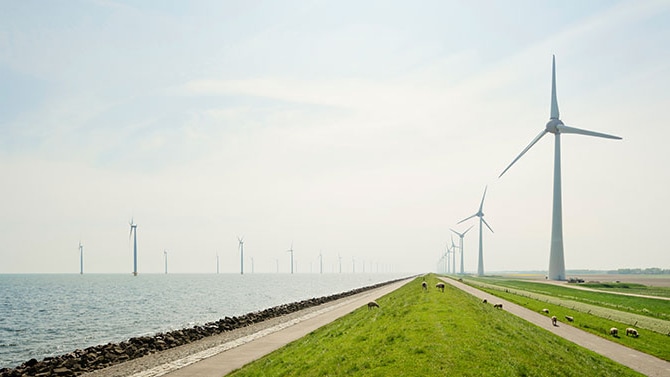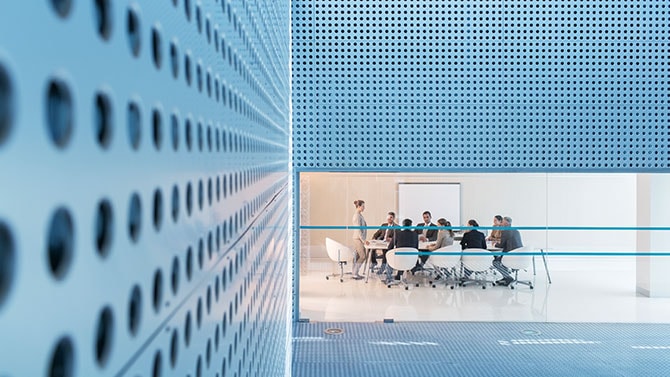Energy transition and responsible consumption
Our net zero commitment reinforces our long term ambition to eliminate our energy emissions by both transitioning to renewable energy sources, and reducing our energy demand profile to align with a net zero energy strategy.
The energy price spike in 2022 demonstrated the UK’s vulnerability to volatile energy costs, highlighting tensions between security, affordability and sustainability. While prices have since subsided, they remain volatile, reinforcing our need to focus on supporting an energy transition that addresses both energy supply and demand, while creating positive outcomes for people, society and the planet.
We’ve been focused on reducing our operational energy use since 2007, easing pressure on the decarbonisation of the UK’s energy supply, and increasing renewable energy supply both on site and via the energy we procure. We’ve invested heavily in reducing our energy consumption, and transitioned 100% of our offices to renewable electricity. As a result our office related emissions no longer contribute significantly to our total greenhouse emissions. However, we continue to remain focused on improving energy efficiency across our offices, when our people work at home, and across our value chain, especially with regards to the impact of the tech we use.
By reimagining how we run and occupy our offices, we’ve cut our buildings' energy consumption by 62% and the associated carbon footprint by 81%, saving us over £48 million in cumulative energy costs since 2007. We’ve created a deep dive Acting on Carbon lessons learnt document to share and bring our actions to life.
We did this using four main levers: just under a third came from changing how we operate our buildings; reducing our space from 9.6 to 6.7 square metres per person has contributed 36%; refreshing our real estate or moving to more efficient building stock has contributed 11%; and around a quarter came from investing in new technologies.
Combined, this equates to 51 million kWh of energy saved – enough to power 3,400 homes for a whole year. Although part of this is a result of consolidating our office floor space, we’ve still seen a 61% drop in energy use per square metre.
| Our 2025 energy transition and responsible consumption targets | |
|---|---|
Metric |
Ongoing targets |
PwC office EUI (Energy Usage Intensity) |
Reduce our office EUI by 24% by FY25 (FY19 baseline) |
PwC office energy consumption |
Reduce our office energy consumption by 15% by FY25 (FY19 baseline) |
Electricity from renewable sources |
Source 100% of our electricity from renewable sources from FY22 |
Our approach
Our top-down target and energy policy form the basis for our approach, which includes:
- automated metering to understand where we're using the most energy and to prioritise our reduction efforts
- consolidating and reconfiguring our office space to operate in a way that drives efficiencies, encourages emerging ways of working, and the latest thinking on wellbeing
- raising the bar in green buildings by pioneering sustainability standards in our building design and operations
- investing in new energy efficient technologies
- encouraging our people to work sustainably
- investing in renewable energy, either by generating our own renewable energy or buying energy from certified renewable sources whenever practicable
Our environmental management system has been certified to the ISO 14001 standard since 2008, and our energy management system to ISO 50001 since 2012. The standard recognises that we have a robust system to manage our energy, and guides us in continually reducing the energy we consume.

How we’re investing in renewable energy
Where possible, we’ve switched to low-carbon alternatives for energy in our buildings. In 2023, 95% of our total energy was sourced from renewables, supported by 1.8 MWh of onsite capacity via our trigenerators and photovoltaic panels.
Since 2015, we’ve been buying electricity from renewable providers where possible, backed by Renewable Energy Guarantee of Origin (REGO) certificates, for all the mainland UK offices that we operate ourselves. We then encouraged the majority of our landlord-owned buildings to switch to renewable tariffs. For the remaining electricity that is not covered, we purchase unbundled Energy Attribute Certificates (EACs), hence reaching our 100% renewable electricity target by 2022.
Originally, our trigenerators were run on recycled cooking oil, however they have since been retrofitted to run on 100% carbon neutral biogas, backed by Renewable Gas Guarantees of Origin (RGGO) certificates.
The remaining 5% of energy is landlord-controlled natural gas consumption, which we’re aiming to phase out from our portfolio.
While renewable energy is zero carbon, it can disincentive further reduction efforts. So going forwards, we’ll be equally focused on the Energy Usage Intensity (EUI) of our buildings, both on an individual building standpoint but also from a UK building portfolio perspective, aiming to reduce this to a level commensurate with a Net Zero future - with guidance rates such as 70 kWh/m² (NLA) / year currently tabled by the UK Green Building Council (UKGBC) energy performance targets.
Examples of how we’re raising the bar in green buildings
A key challenge in moving to a low carbon economy is dealing with old building stock. So, with the ongoing upgrade of our UK offices, we’re challenging ourselves on the art of the possible. Our London offices at More London and Embankment place, and our Leeds office have all achieved the ‘Outstanding’ rating under BREEAM, the world’s foremost environmental rating system for buildings, while another 5 offices have achieved the ‘Excellent’ rating. This means we now have more than 20,000 of our people located in some of the most innovative and environmentally-friendly buildings in the UK.
We’re also applying many of the lessons and BREEAM principles to the ongoing investment in the upgrade of our other offices.

One Chamberlain Square, Birmingham - Achieved BREEAM offices ‘Excellent’ for both new construction and fit out
Statistics:
- BREEAM (Refurbishment and fit out 2014) score Outstanding 72% (in design)
- 7.2 m² per FTE
- 100% renewable energy
- EPC rating B 36
- Zero waste to landfill
- Green roof? yes
Overview: Our move to this landmark new building in January 2020 signified the firm’s continued growth in the Midlands. The firm’s 2,000-strong team occupies all of the commercial space in the 7 story, 14,500m² office building. PwC chose to manage the whole building, providing complete control and influence over future running and Net Zero commitments. To ensure sustainability was placed at the centre of the design, we collaborated with suppliers to implement new technologies and processes, aligning with our low carbon and circular business principles.
Key features:
- Runs on 100% renewably sourced energy, with electricity being sourced from 100% UK wind and solar, and gas supplied from 100% UK sourced biogas, derived from waste food and crops generated from an anaerobic digestion process.
- A Dali Lighting system and LED lights with occupancy and daylight sensing provides energy-efficient lighting throughout the building.
- An intelligent BMS with integration across all systems, with an integrated energy management system that learns the building’s usual daily consumption profiles.
- The ability to control specific floors with the HVAC system, allowing a modular approach to running the building depending on occupancy.
- Freespace PIR sensors installed at every worksetting, with display screens showing worksetting usage and availability, providing live utilisation data and enabling efficient space management.
- Metering and submetering systems to monitor energy use
- Cycle parking, showers, drying room and lockers installed to meet BREEAM criteria for 3000 occupants
- Water consumption and leak detection installed
- ‘Going Circular’ with redundant furniture from the previous office.

Merchant Square, Belfast - First office in Northern Ireland to achieve BREEAM ‘Excellent’ rating for retrofit
Statistics:
- BREEAM (Refurbishment and fit out 2014) score Excellent 71.8% (in design)
- 7.0 m² per FTE
- 100% renewable energy
- EPC rating: A 25
- Zero waste to landfill
- Green roof? no
Overview: Our largest office outside of London, we are the sole tenant of this 20,000 m² building, accommodating 3,400 of our people across 9 floors. Being our most advanced workplace to date, with sustainability at the core of its design, it is perfectly positioned as an enabler for PwC to meet its future Net Zero targets, through the focus on sustainability, agility and the ability to flex space to match supply with demand. Innovations have been implemented to drive the firm’s agile initiatives and commitment to Net Zero.
Key features:
- Designed to operate solely from electricity, negating any need to use fossil fuels for heating. This means it uses about half as much energy per square metre than the previous office and is now running on 100% renewable energy.
- Materials from the old building were reused, and 97% of all furniture, fixtures and fittings from the old office were donated to 55 charities, social enterprises, community groups and schools.
- Uses much of the foundations and structure of the original buildings, thereby reducing the amount of embodied carbon from construction.
- Modular VRF HVAC system which enables the building to utilise space efficiently by turning off areas and floors when they are not being used.
- Sophisticated iBMS system which controls all of the systems within the building including a Dali controlled lighting system incorporating daylight sensing.
- Smart storage and powered USBC connectivity to remove ‘anchors’ inhibiting fluidity of occupation required to meet Net Zero aspirations.
- Cycle parking, showers, drying room and lockers installed to meet BREEAM criteria for 3000 occupants
- Enhancing the hybrid working experience, active face and voice tracking and bluetooth connectivity was implemented in meeting rooms
- Removal of post pigeon holes, central file drop and reducing MFD’s to support the firm’s digitisation.

More on our environmental impact
Contact us

















